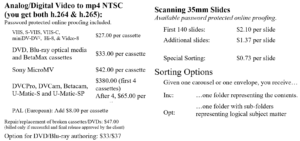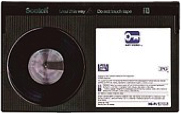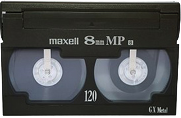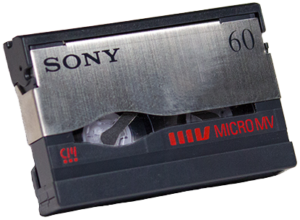Consumer Video
Assure the Preservation of a Lifetime of Photos and Home Movies
Highest Quality Transfers and Restorations
Featuring online password protected proofing. View before you buy. Decide which ones to preserve for generations yet unborn.
We process both NTSC (North American Television Standard) and the European PAL formats. No matter where in the world your video was recorded, we can probably duplicate it to the digital domain.
More than a Simple Transfer or Duplication to Digital
Operating in Ann Arbor, Chelsea, and all of SE Michigan including Greater Detroit, we employ advanced image enhancement technology for deinterlacing legacy VHS. VHS-C. S-VHS, MicroMV, DVCPro, DVCam, U-Matic, U-Matic-SP, BetaMax, digiBeta. miniDV, and Hi-8 videos duplicated to mp4 computer files. In addition, special attention is given to precision de-interlacing of legacy video for display on modern progressive scan technology TVs and computers. Please view a blog post we have explaining details of this with examples showing the stunning difference accurate de-interlacing makes.
We accept media recorded in either the European PAL or North American NTSC format.
Why Transfer to Digital
Analog magnetic tape used in video is estimated to begin to show significant degradation after ten years. Digitally recorded tape may give the appearance of lasting longer because of its error correction and ability to drop frames without being noticed. Even consumer-grade DVDs are subject to rapid aging making it extremely important to only use professional-grade media when your memories are at stake. But digital mp4 is even better. MP4’s biggest attraction is that we can release video in 1080p while the DVD is only capable of 480p resolution since it was defined in the 1990s.
But there is more to mp4 that we have to offer. MP4 video has, and continues to be, released using the h.264 CODEC. However, recent advances in technology have produced a new CODEC for mp4 called h.265. H.265 has the same quality as h.264 but roughly 60% the file size making it a very great improvement for streaming. But there is a problem…because h.265 is new, many players do not have the h.265 CODEC installed. A day will come when all players use the h.265 CODEC. Therefore, at W. Cardone Productions we include both h.264 and h.265 versions with all releases of clients’ legacy home movie video.
Why W. Cardone
W. Cardone Productions has the latest technology to do your photo and home movie transfer to digital. We offer complimentary options for restoring and/or improving the quality of both aged celluloid and video home movies as well as still pictures and audio.
Please call for details on what specific capabilities exist and for pricing. We may be able to offer free pickup and delivery. If you choose to use a credit card we use wireless chip reader technology at your door for maximum security.
And remember that ALL legacy video is fully de-interlaced during our original download. Please view our blog post which explains this.
Supplemental release on DVD media is available for a nominal fee.

Consumer Video (both NTSC and PAL)
VHS and the rare S-VHS to Digital
S-VHS was a very late digital upgrade to the analog VHS format. Video cassettes recorded using the S-VHS format are digital rather than analog are equal to the later MiniDV (digital video) format.
An S-VHS cassette is identical to a VHS cassette in appearance. In fact, a cassetted manufactured for use in a VHS machine could be recorded in an S-VHS machine though it was claimed some quality would be lost.
VHS-C to Digital
 The VHS-C cassette could be described as a VHS cassette disguised to look like VHS to the machine but be physically much smaller. Because the physical size of the VHS-C cassette was very small it allowed the new camcorders to be much smaller as well. Yet the VHS-C cassette could be used in the existing video VHS players with the use of an inexpensive adapter. Consumers didn’t need to buy new players.
The VHS-C cassette could be described as a VHS cassette disguised to look like VHS to the machine but be physically much smaller. Because the physical size of the VHS-C cassette was very small it allowed the new camcorders to be much smaller as well. Yet the VHS-C cassette could be used in the existing video VHS players with the use of an inexpensive adapter. Consumers didn’t need to buy new players.
.
Beta or BetaMax to Digital
 Released by Sony in 1975, the Betamax format competed with VHS for market dominance. It was technically slightly better than VHS but sadly, it lost the war and VHS emerged to dominate the market.
Released by Sony in 1975, the Betamax format competed with VHS for market dominance. It was technically slightly better than VHS but sadly, it lost the war and VHS emerged to dominate the market.
DigiBeta or Betacam SP to Digital
Formats of Betacam, Betacam SP, Betacam SX, digital Betacam (DigiBeta) and MPEG IMX cassettes are covered under this professional territory. These formats have been used primarily by TV news gathering agencies. We process both NTSC and PAL formats.

8mm and Hi-8 Video to DVD
 The Video 8 format succeeded VHS introducing new quality of picture. A later improvement, the Hi-8 format, provided even yet improved performance but using the same cassette.
The Video 8 format succeeded VHS introducing new quality of picture. A later improvement, the Hi-8 format, provided even yet improved performance but using the same cassette.
MiniDV to Digital
MiniDV cassettes are used for recording baseline DV, DVCAM, and HDV. Each tape holds about 13 GB for one hour of video. These were extremely popular beginning about the year 2000. We are seeing more and more of these as they move into the legacy market.
MicroMV to Digital
 The Sony microMV format was a relatively short-lived format that had very distinct advantages over the extremely popular miniDV format. Most notably was that it was 70% smaller than the miniDV format cassette. While it was small, it held as much video time-wise as the miniDV. But therein was its hidden disadvantage that likely served to its downfall. It maintained length equality with miniDV by means of compression similar to what is used in DVDs. This gave the format a very great liability with those wanting to edit their video footage. Because of the compression, it was difficult to avoid artifacts in edits that owners did without a knowledge of how to circumvent those limitations.
The Sony microMV format was a relatively short-lived format that had very distinct advantages over the extremely popular miniDV format. Most notably was that it was 70% smaller than the miniDV format cassette. While it was small, it held as much video time-wise as the miniDV. But therein was its hidden disadvantage that likely served to its downfall. It maintained length equality with miniDV by means of compression similar to what is used in DVDs. This gave the format a very great liability with those wanting to edit their video footage. Because of the compression, it was difficult to avoid artifacts in edits that owners did without a knowledge of how to circumvent those limitations.
Both U-Matic and U-Matic SP to Digital
 U-Matic was an analogue recording video cassette format introduced to the market in September 1971. It was among the first video formats to contain the videotape inside a cassette, as opposed to the various reel-to-reel or open-reel formats of the time.
U-Matic was an analogue recording video cassette format introduced to the market in September 1971. It was among the first video formats to contain the videotape inside a cassette, as opposed to the various reel-to-reel or open-reel formats of the time.
U-Matic SP (Superior Performance) was a variant of the U-Matic video cassette format that used chrome tape and offered improved in performance.
These cassettes are virtually unknown to today’s consumer public. In their day they were priced outside the consumer market and only used by TV stations and other professionals. We only see this legacy format on rare occasions.
